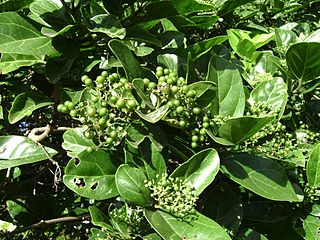
Clownfish or anemonefish are fishes from the subfamily Amphiprioninae in the family Pomacentridae. Thirty species are recognized: one in the genus Premnas, while the remaining are in the genus Amphiprion. In the wild, they all form symbiotic mutualisms with sea anemones. Depending on species, anemonefish are overall yellow, orange, or a reddish or blackish color, and many show white bars or patches. The largest can reach a length of 15–16 cm (5.9–6.3 in), while the smallest barely achieve 7–8 cm (2.8–3.1 in).

Premnas biaculeatus, commonly known as spine-cheeked anemonefish or the maroon clownfish, is a species of anemonefish found in the Indo-Pacific from western Indonesia to Taiwan and the Great Barrier Reef. They can grow up to be about 17 cm (6.7 in). Like all anemonefishes it forms a symbiotic mutualism with sea anemones and is unaffected by the stinging tentacles of the host anemone. It is a sequential hermaphrodite with a strict size-based dominance hierarchy; the female is largest, the breeding male is second largest, and the male nonbreeders get progressively smaller as the hierarchy descends. They exhibit protandry, meaning the breeding male changes to female if the sole breeding female dies, with the largest nonbreeder becoming the breeding male. The fish's natural diet includes algae and zooplankton.

Manas National Park or Manas Wildlife Sanctuary (Pron:ˈmʌnəs) is a national park, UNESCO Natural World Heritage site, a Project Tiger reserve, an elephant reserve and a biosphere reserve in Assam, India. Located in the Himalayan foothills, it is contiguous with the Royal Manas National Park in Bhutan. The park is known for its rare and endangered endemic wildlife such as the Assam roofed turtle, hispid hare, golden langur and pygmy hog. Manas is famous for its population of the wild water buffalo.
Premna grandifolia is a small shrub in the family Lamiaceae. It is endemic to Ivory Coast. It is threatened by habitat loss.

Premna is a genus of flowering plants in the mint family, Lamiaceae, first described for modern science in 1771. It is widespread through tropical and subtropical regions in Africa, southern Asia, northern Australia, and various islands in the Pacific and Indian Oceans.
- Premna acuminataR.Br. - Australia, New Guinea
- Premna acutataW.W.Sm. - southwestern China
- Premna albaH.J.Lam - Palau
- Premna ambongensisMoldenke - Madagascar
- Premna amplectensWall. ex Schauer - Thailand, Myanmar
- Premna angolensisGürke - tropical Africa
- Premna angustifloraH.J.Lam - Palau
- Premna annulataH.R.Fletcher - Thailand, Laos, Vietnam
- Premna aureolepidotaMoldenke - Madagascar
- Premna balakrishnaniiA.Rajendran & P.Daniel - Tamil Nadu
- Premna balansaeDop - Vietnam
- Premna barbataWall. ex Schauer - Indian Subcontinent, Myanmar
- Premna bengalensisC.B.Clarke - Indian Subcontinent, Myanmar, Vietnam
- Premna bequaertiiMoldenke - Uganda, Rwanda, Zaïre
- Premna bracteataWall. ex C.B.Clarke - Himalayas, Tibet, Yunnan, Nepal, Assam, Bhutan, Myanmar
- Premna cambodianaDop - Cambodia, Vietnam
- Premna cavalerieiH.Lév - China
- Premna chevalieriDop - Thailand, Laos, Vietnam, China
- Premna chrysoclada(Bojer) Gürke - Kenya, Tanzania, Guinea-Bissau
- Premna collinsaeCraib - Thailand
- Premna confinisC.Pei & S.L.Chen ex C.Y.Wu - China
- Premna congolensisMoldenke - Zaïre, Angola, Cabinda
- Premna cordifoliaRoxb. - Thailand, Vietnam, Malaya
- Premna coriaceaC.B.Clarke - Indian Subcontinent, Thailand, Andaman Islands
- Premna corymbosaRottler - India, Sri Lanka, Andaman & Nicobar Islands
- Premna crassaHand.-Mazz. - Vietnam, China
- Premna debianaA.Rajendran & P.Daniel - Arunachal Pradesh
- Premna decaryiMoldenke - Madagascar
- Premna decurrensH.J.Lam - Indonesia
- Premna discolorVerdc. - Kenya
- Premna dubiaCraib - Laos, Thailand, Vietnam
- Premna esculentaRoxb. - Assam, Bangladesh, Myanmar, Thailand
- Premna fohaiensisC.Pei & S.L.Chen ex C.Y.Wu - China (Yunnan)
- Premna fordiiDunn - China
- Premna fulvaCraib - Indochina, Indonesia, China
- Premna garrettiiH.R.Fletcher - Thailand
- Premna glaberrimaWight - southern India
- Premna glandulosaHand.-Mazz. - China (Yunnan)
- Premna gracillimaVerdc. - Kenya, Tanzania
- Premna grandifoliaA.D.J. Meeuse, illegitimate name, = Premna hutchinsonii
- Premna grossaWall. ex Schauer - Myanmar
- Premna guillauminiiMoldenke - New Caledonia
- Premna hainanensisChun & F.C.How - China (Hainan)
- Premna hans-joachimiiVerdc. - Tanzania
- Premna henryana(Hand.-Mazz.) C.Y.Wu - China
- Premna herbaceaRoxb. - Himalayas, Yunnan, Indian Subcontinent, Southeast Asia, Indonesia, New Guinea, northern Australia
- Premna hildebrandtiiGürke - Zaire, Kenya, Tanzania, Mozambique, Zimbabwe
- Premna hispidaBenth. - West Africa
- Premna humbertiiMoldenke - Madagascar
- Premna hutchinsoniiMoldenke - Ivory Coast
- Premna interruptaWall. ex Schauer - southern China, Himalayas, Indochina
- Premna jalpaigurianaT.K.Paul - West Bengal
- Premna khasianaC.B.Clarke - Assam, Thailand
- Premna lepidellaMoldenke - Madagascar
- Premna ligustroidesHemsl - China
- Premna longiacuminataMoldenke - Madagascar
- Premna longifoliaRoxb. - Himalayas
- Premna longipetiolataMoldenke - Madagascar
- Premna lucensA.Chev. - West Africa
- Premna macrophyllaWall. ex Schauer - Assam, Indochina
- Premna madagascariensisMoldenke - Madagascar
- Premna mariannarumSchauer - Mariana Islands
- Premna matadiensisMoldenke - Zaïre, Angola
- Premna maximaT.C.E. Fr. - Kenya
- Premna mekongensisW.W.Sm. - China (Yunnan)
- Premna micranthaSchauer - India, Assam, Bangladesh
- Premna microphyllaTurcz. - Japan, Ryukyu Islands, China
- Premna millefloraC.B.Clarke - Assam
- Premna milneiBaker - Nigeria, Bioko
- Premna minorDomin - Queensland
- Premna mollissimaRoth - Indian Subcontinent, Yunnan, Indochina, Philippines
- Premna mooiensis(H.Pearson) W.Piep - Mozambique, Swaziland, South Africa
- Premna mortehaniiDe Wild - Zaïre
- Premna mundanthuraiensisA.Rajendran & P.Daniel - Tamil Nadu
- Premna neurophyllaChiov. - Ethiopia
- Premna oblongataMiq. - Indonesia, Philippines
- Premna odorataBlanco - - Indian Subcontinent, Yunnan, Southeast Asia, New Guinea, northern Australia; naturalized in Miami-Dade County in Florida
- Premna oliganthaC.Y.Wu - China
- Premna oligotrichaBaker - Ethiopia, Somalia, Kenya, Tanzania
- Premna orangeanaCapuron - Madagascar
- Premna paisehensisC.Pei & S.L.Chen - China (Guangxi)
- Premna pallescensRidl.- Borneo, Indonesia
- Premna parasiticaBlume - Indonesia
- Premna parvilimbaC.Pei - China (Yunnan)
- Premna paucinervis(C.B.Clarke) Gamble - Kerala, Tamil Nadu
- Premna paulobarbataH.J.Lam - Mariana Islands
- Premna perplexansMoldenke - Madagascar
- Premna perrieriMoldenke - Madagascar
- Premna pinguisC.B.Clarke - Assam, Bangladesh, Myanmar, Java
- Premna politaHiern - Angola
- Premna procumbensMoon - India, Bangladesh, Sri Lanka
- Premna protrusaA.C.Sm. & S.Darwin - Fiji
- Premna puberulaPamp. - China
- Premna pubescensBlume - Indonesia, Philippines, Christmas Island
- Premna puerensisY.Y.Qian - China (Yunnan)
- Premna punduanaWall. ex Schauer - Arunachal Pradesh, Assam, Bangladesh
- Premna puniceaC.Y.Wu - China (Yunnan)
- Premna purpurascensThwaites - Sri Lanka
- Premna quadrifoliaSchumach. & Thonn. - West Africa
- Premna rabakensisMoldenke - Cambodia
- Premna regularisH.J.Lam - Philippines, Indonesia, New Guinea
- Premna repensH.R.Fletcher - Thailand
- Premna resinosa(Hochst.) Schauer - East Africa, Arabian Peninsula, India
- Premna richardsiaeMoldenke - Tanzania
- Premna rubroglandulosaC.Y.Wu - China (Yunnan)
- Premna scandensRoxb. - China (Yunnan), Himalayas, Andaman Island, Indochina
- Premna schimperiEngl - East Africa
- Premna schliebeniiWerderm. - Tanzania, Mozambique
- Premna scoriarumW.W.Sm. - Tibet, Yunnan, Myanmar
- Premna senensisKlotzsch - eastern + central Africa
- Premna serrataH.R.Fletcher - Thailand
- Premna serratifoliaL. - widespread in East Africa, the Indian Subcontinent, Southeast Asia, northern Australia, islands of Pacific + Indian Oceans
- Premna siamensisH.R.Fletcher - Thailand
- Premna stenobotrysMerr. - Vietnam
- Premna steppicolaHand.-Mazz. - China
- †Premna sterculiifoliaKing & Gamble - Malaya but extinct
- Premna straminicaulisC.Y.Wu - China (Yunnan)
- Premna subcapitataRehder - China
- Premna sulphurea(Baker) Gürke - Angola
- Premna sunyiensisC.Pei - China (Guangdong)
- Premna szemaoensisPei - China (Yunnan)
- Premna tahitensisJ.Schauer - many islands of the Pacific
- Premna tanganyikensisMoldenke - Tanzania, Mozambique
- Premna tapintzeanaDop - China (Yunnan)
- Premna teniiC.Pei - China (Yunnan)
- Premna thoreliiDop - Laos
- Premna thwaitesiiC.B.Clarke - Sri Lanka
- Premna tomentosaWilld. - Indian Subcontinent, Southeast Asia, Queensland, Solomon Islands
- Premna trichostomaMiq. - Southeast Asia, Indonesia, New Guinea
- Premna urticifoliaRehder - China (Yunnan)
- Premna velutinaGürke - Burundi, Kenya, Tanzania, Mozambique
- Premna venulosaMoldenke - Madagascar
- Premna wightianaSchauer - India, Sri Lanka
- Premna wuiBoufford & B.M.Barthol. - China (Yunnan)
- Premna yunnanensisW.W.Sm - China
Premna hans-joachimii is a species of plant in the family Lamiaceae. It is endemic to Tanzania.
Premna maxima is a species of plant in the family Lamiaceae. It is endemic to Kenya.
Premna protrusa is a species of plant in the family Lamiaceae. It is endemic to Fiji.
Premna schliebenii is a species of plant in the family Lamiaceae. It is found in Mozambique and Tanzania.
Premna taitensis is a species of plant in the family Lamiaceae. It is endemic to French Polynesia.
Premna tanganyikensis is a species of plant in the family Lamiaceae. It is found in Mozambique and Tanzania.
Cosmoclostis pesseuta is a species of moth of the family Pterophoridae. It is found in India and Sri Lanka but has also been recorded from New Guinea and the Bismarck Archipelago. Recently, it has also been collected in Queensland, Australia.

Premna serratifolia is a small tree/shrub in the family Lamiaceae. It flowers and fruits between May and November. During flowering season, it attracts a large number of butterflies and bees. Synonyms of Premna serratifolia Linn. include P. corymbosa Merr., P. integrifolia L. and P. obtusifolia R. Br.).
Phyllocnistis titania is a moth of the family Gracillariidae, known from Sumatra, Indonesia. The hostplant for the species is Premna tomentosa.

Cleora repetita is a species of moth of the family Geometridae first described by Arthur Gardiner Butler in 1882. It is found from Sundaland to Australia and the Solomon Islands.
Premna barbata is a plant species in the genus Premna, first described in 1847. It is native to Myanmar and to the Indian Subcontinent.
Premna acuminata, commonly known as the firestick tree, or ngalinginkil in the Bardi language, is a species of plant in the mint family. It is native to northern Australia where it occurs from Western Australia through the Northern Territory to Queensland.
Premna mollissima, the dusky fire brand mark, is an 8m high small tree in the family Lamiaceae. It is found in India, Bangladesh, and Sri Lanka.
Ozola microniaria is a moth of the family Geometridae first described by Francis Walker in 1862. It is found in Sri Lanka.
Premna odorata, known as fragrant premna, is a species in the genus Premna native to the Indian Subcontinent, Yunnan, Southeast Asia, New Guinea, and northern Australia, and naturalized in southern Florida








